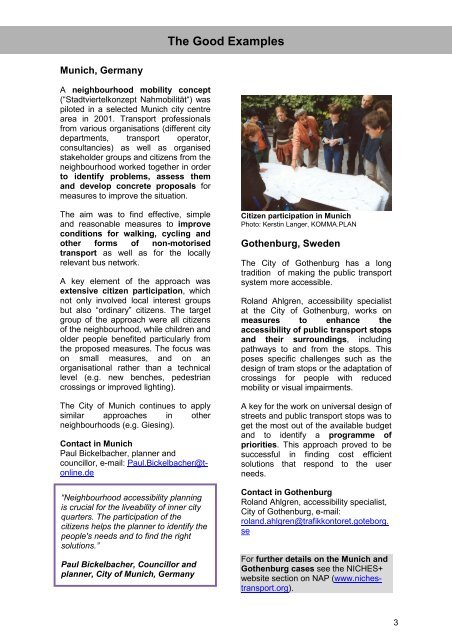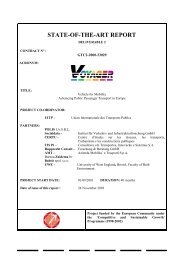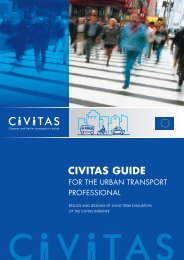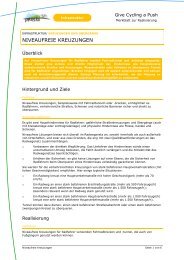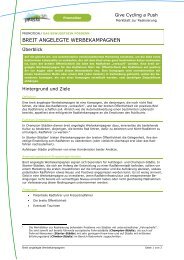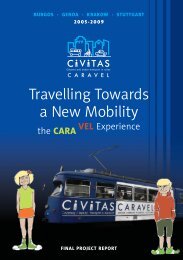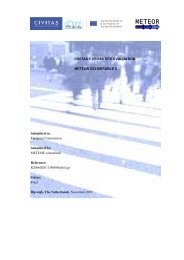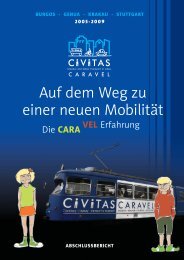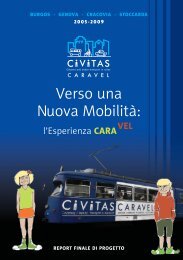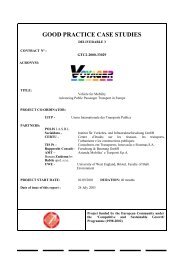NICHES+ Artois-Gohelle Neighbourhood Accessibility Planning
NICHES+ Artois-Gohelle Neighbourhood Accessibility Planning
NICHES+ Artois-Gohelle Neighbourhood Accessibility Planning
Create successful ePaper yourself
Turn your PDF publications into a flip-book with our unique Google optimized e-Paper software.
The Good Examples<br />
Munich, Germany<br />
A neighbourhood mobility concept<br />
(“Stadtviertelkonzept Nahmobilität“) was<br />
piloted in a selected Munich city centre<br />
area in 2001. Transport professionals<br />
from various organisations (different city<br />
departments, transport operator,<br />
consultancies) as well as organised<br />
stakeholder groups and citizens from the<br />
neighbourhood worked together in order<br />
to identify problems, assess them<br />
and develop concrete proposals for<br />
measures to improve the situation.<br />
The aim was to find effective, simple<br />
and reasonable measures to improve<br />
conditions for walking, cycling and<br />
other forms of non-motorised<br />
transport as well as for the locally<br />
relevant bus network.<br />
A key element of the approach was<br />
extensive citizen participation, which<br />
not only involved local interest groups<br />
but also “ordinary” citizens. The target<br />
group of the approach were all citizens<br />
of the neighbourhood, while children and<br />
older people benefited particularly from<br />
the proposed measures. The focus was<br />
on small measures, and on an<br />
organisational rather than a technical<br />
level (e.g. new benches, pedestrian<br />
crossings or improved lighting).<br />
The City of Munich continues to apply<br />
similar approaches in other<br />
neighbourhoods (e.g. Giesing).<br />
Contact in Munich<br />
Paul Bickelbacher, planner and<br />
councillor, e-mail: Paul.Bickelbacher@tonline.de<br />
“<strong>Neighbourhood</strong> accessibility planning<br />
is crucial for the liveability of inner city<br />
quarters. The participation of the<br />
citizens helps the planner to identify the<br />
people's needs and to find the right<br />
solutions.”<br />
Paul Bickelbacher, Councillor and<br />
planner, City of Munich, Germany<br />
Citizen participation in Munich<br />
Photo: Kerstin Langer, KOMMA.PLAN<br />
Gothenburg, Sweden<br />
The City of Gothenburg has a long<br />
tradition of making the public transport<br />
system more accessible.<br />
Roland Ahlgren, accessibility specialist<br />
at the City of Gothenburg, works on<br />
measures to enhance the<br />
accessibility of public transport stops<br />
and their surroundings, including<br />
pathways to and from the stops. This<br />
poses specific challenges such as the<br />
design of tram stops or the adaptation of<br />
crossings for people with reduced<br />
mobility or visual impairments.<br />
A key for the work on universal design of<br />
streets and public transport stops was to<br />
get the most out of the available budget<br />
and to identify a programme of<br />
priorities. This approach proved to be<br />
successful in finding cost efficient<br />
solutions that respond to the user<br />
needs.<br />
Contact in Gothenburg<br />
Roland Ahlgren, accessibility specialist,<br />
City of Gothenburg, e-mail:<br />
roland.ahlgren@trafikkontoret.goteborg.<br />
se<br />
For further details on the Munich and<br />
Gothenburg cases see the <strong>NICHES+</strong><br />
website section on NAP (www.nichestransport.org).<br />
3


